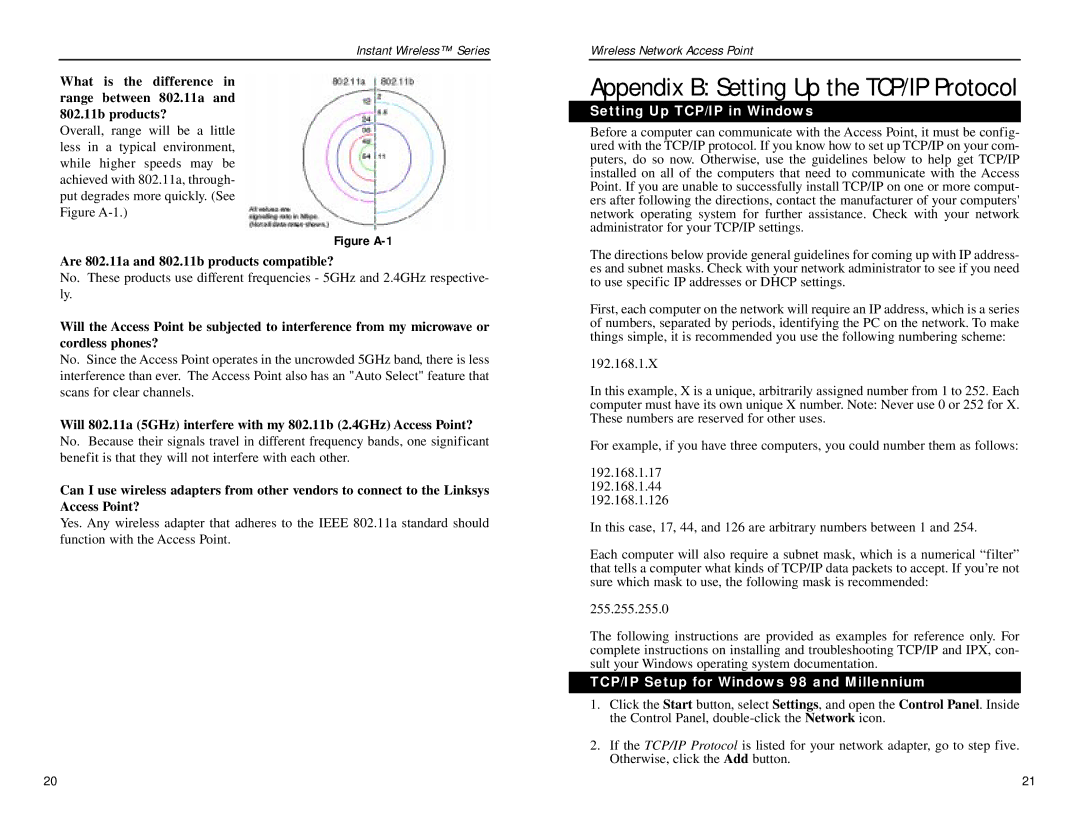
Instant Wireless™ Series
What is the difference in range between 802.11a and 802.11b products?
Overall, range will be a little less in a typical environment, while higher speeds may be achieved with 802.11a, through- put degrades more quickly. (See Figure
Figure A-1
Are 802.11a and 802.11b products compatible?
No. These products use different frequencies - 5GHz and 2.4GHz respective- ly.
Will the Access Point be subjected to interference from my microwave or cordless phones?
No. Since the Access Point operates in the uncrowded 5GHz band, there is less interference than ever. The Access Point also has an "Auto Select" feature that scans for clear channels.
Will 802.11a (5GHz) interfere with my 802.11b (2.4GHz) Access Point?
No. Because their signals travel in different frequency bands, one significant benefit is that they will not interfere with each other.
Can I use wireless adapters from other vendors to connect to the Linksys Access Point?
Yes. Any wireless adapter that adheres to the IEEE 802.11a standard should function with the Access Point.
Wireless Network Access Point
Appendix B: Setting Up the TCP/IP Protocol
Setting Up TCP/IP in Windows
Before a computer can communicate with the Access Point, it must be config- ured with the TCP/IP protocol. If you know how to set up TCP/IP on your com- puters, do so now. Otherwise, use the guidelines below to help get TCP/IP installed on all of the computers that need to communicate with the Access Point. If you are unable to successfully install TCP/IP on one or more comput- ers after following the directions, contact the manufacturer of your computers' network operating system for further assistance. Check with your network administrator for your TCP/IP settings.
The directions below provide general guidelines for coming up with IP address- es and subnet masks. Check with your network administrator to see if you need to use specific IP addresses or DHCP settings.
First, each computer on the network will require an IP address, which is a series of numbers, separated by periods, identifying the PC on the network. To make things simple, it is recommended you use the following numbering scheme:
192.168.1.X
In this example, X is a unique, arbitrarily assigned number from 1 to 252. Each computer must have its own unique X number. Note: Never use 0 or 252 for X. These numbers are reserved for other uses.
For example, if you have three computers, you could number them as follows:
192.168.1.17
192.168.1.44
192.168.1.126
In this case, 17, 44, and 126 are arbitrary numbers between 1 and 254.
Each computer will also require a subnet mask, which is a numerical “filter” that tells a computer what kinds of TCP/IP data packets to accept. If you’re not sure which mask to use, the following mask is recommended:
255.255.255.0
The following instructions are provided as examples for reference only. For complete instructions on installing and troubleshooting TCP/IP and IPX, con- sult your Windows operating system documentation.
TCP/IP Setup for Windows 98 and Millennium
1.Click the Start button, select Settings, and open the Control Panel. Inside the Control Panel,
2.If the TCP/IP Protocol is listed for your network adapter, go to step five. Otherwise, click the Add button.
20 | 21 |
